WALL STREET TO MAIN STREET [An Essay]
 Friday, December 23, 2011 at 09:30AM
Friday, December 23, 2011 at 09:30AM By Paul McLean
Mic Check! Mic Check! Mic Check!
Look around
You are a part
of a Global Uprising
We are a Cry
from the Heart
of the World
We are Unstoppable
Another World
is Possible
Happy Birthday
#occupy movement
1
Occupy Wall Street for a short time created direct consequences for those who bear the primary responsibility for our current malaise. We knocked at the door. It was about being there. Calling out corruption, injustice, greed and the systemic debasement of democracy by the 1%, the Occupiers of Zuccotti Park disrupted the message machine of corporate media, which today is to a great extent a service industry for global syndicates. By now, a lot of us know the 1% org-chart. It’s been exposed, through the cloud of obscuration, by a bunch of amateurs, mostly. Here’s a typical Occupy logic thread: Does General Electric own NBC? [1] Does GE pay US taxes? Is the former CEO of GE in the cabinet of President Obama? A hand-painted cardboard sign held aloft by a young occupier may not be much, compared to the power of GE to suspend America’s disbelief, letting ride the reality that our democracy is corporate-owned and super-rich 1% controlled, but it’s something. 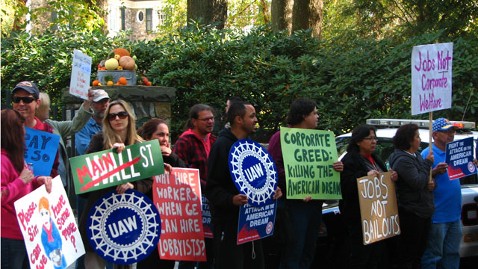
OWS protesting at Jeffrey Immelt’s home
Did OWS manage to straighten out the corruption of US democracy, which GE represents, in the duration of the actual occupation of Liberty Square? The short answer is “No.” OWS wasn’t really capable of that, any more than a temporary projection of light beams is capable of knocking over a high-rise office building. The prime collateral effects so far of OWS – focusing-attention, causing-inconvenience, enforcing-transparency, pushing-accountability, etc. – are not consequences like a guillotine’s consequences for the 1%, but they are something.
Maybe there are more important things than generating consequential phenomena, or after-effects, per se. Positioning is not a negation. A ripple in the water caused by the stone dropped in the pond is not the stone. Maybe tossing the rock is the expression that matters. OWS is like the rock tossed into the pond, drifting down to the bottom, disappearing, while the ripples in concentric circular formations transit the surface.
OWS has platformed expression as itself, again. The signs, the drumming, the chants, the puppets, the speeches, the performances (musical and theatrical)… the People’s Mic: These are protean methods of projecting self-/collective-self into the commons; fundamentally human behavior, but in America it also happens to be good citizenship, when carried out non-violently. 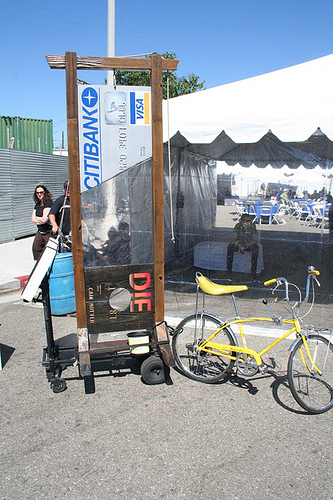
Photo by Paul McLean
Something’s got to give, though. People are fed up. Artists are fed up. Remember what Kennedy said about violent/non-violent protest? I saw a guillotine, pre-9-17, at the Abbot Kinney Festival (2010) in Venice, CA, made by an artist with a new vision for credit applications, and a bloody message implied. The seams in the social contract are starting to fray. Maybe in Oakland’s occupation they threw rocks, but as far as I know, that never happened in OWS. But what did happen at Occupy Wall Street? Baudrillard might have said that the something that happened between September 17 and November 15 never happened, and we have the pictures and video to prove it. OWS may not have destroyed the 1%, but it was something, something expressed. That expression continues, like ripples across a pond.
2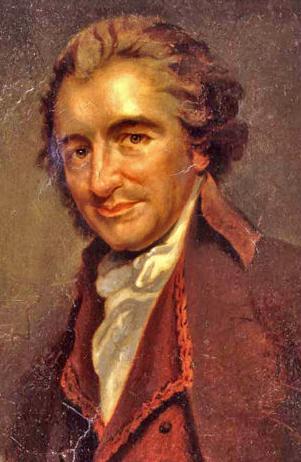
Thomas Paine
When, therefore, a country becomes populous by the additional aids of cultivation, art and science, there is a necessity of preserving things in that state; because without it there cannot be sustenance for more, perhaps, than a tenth part of its inhabitants. The thing, therefore, now to be done is to remedy the evils and preserve the benefits that have arisen to society by passing from the natural to that which is called the civilized state. - Thomas Paine, "Agrarian Justice"
The “Bat Signal” of N17 is a fine (new media) example of projected humanity, or maybe “version” is a better word than sample. To recount the 99% setting: the semiotic sign of “us” floating on the architecture of comm-tech power; pronouncing and affirming our claim to redress grievances through peaceful assembly; our burgeoning re-enlightened moment in movement, post-eviction; sparking a vision of power in numbers; overcoming the restraints of police action, which had foiled the first attempt to take the message en masse off the island of Manhattan to the rest of the world, or at least to Brooklyn; for every witness a new age dawning, of collective celebration; the event streamed on the web IRT/IRL (in Real Time and LIfe); an emergency call to the superhero in us, carried on beams of light above the heads of thirty or forty thousand souls; crossing that bridge, when they came to it.
No harm was done to the Verizon building by the 99% projection, right? 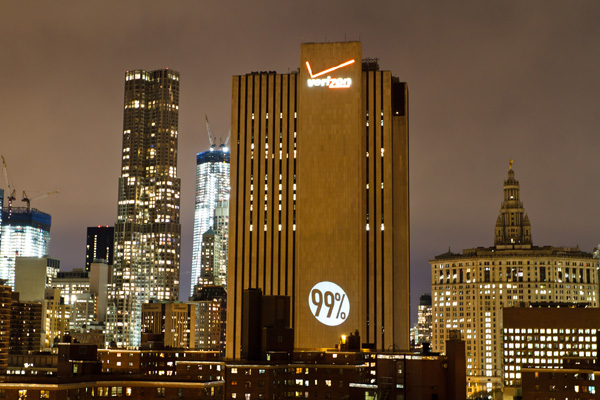
Photo by Brandon Neubauer
By the way - it was a Hudson Valley artist who pulled off that particular stunt, named Mark Read. [2] Not to say he acted alone. It was a team effort, naturally. Sorry, if this seems like a non-sequitor: Is it time to introduce Thomas Cole into our dimensional set of necessary considerations for our “Wall Street to Main Street” Occupy with Art project? [3] The website for Cole’s home-as-national-park claims proudly, “This is where American art was born.” That is one beginning of a beginning. The 99% bat signal gave us another.
Revolution is a circular term, is it not? Revolutions are made of one-to-many/many-to-one interchanges, which are not binary configurations, if one remembers that the “ONE” is a point on a circle of many equal points, bent to the order of Pi, which is an infinite form-as-number. The American Revolution was and is like that. George Washington got it in that horrible winter of Valley Forge. Bloomberg made sure that winter bond-forging wasn’t going to happen with OWS. Given the circular or concentricity concept, which is another kind of projection, and holograph, or sketch of reality, and/or hyperreality: then Thomas Cole and Mark Read in a way collaborated on the bat signal. We could even go so far as to say that Verizon and the electric company and the producer of the projector and the witnesses (actual and virtual) were also in on that big 99%/+1% circle, accounting for the bat signal. Maybe the phenomenology is too close to Dr. Bronner’s soap packaging for some of you.
But, so what? There are lots of critiques of OWS, reformations of it, like notes in suggestion boxes, and erasures or attempts at it. Those are third-party interventions. For those of us taking notes, we’re getting at a triangular formation, which will hold additional meaning for the Masons among us, especially those with an eye towards the pinnacle of the big pyramid scheme. Where you have Orders, you’re bound to have anti-orders. At some point we have to contradict the emerging OWS anarchist storyline here. [4] At the same time, we ought to consider the nature of agrarian justice, as envisioned by Founder Thomas Paine. [5] 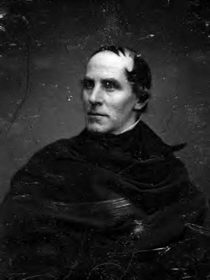
Thomas Cole
3
A corporation is an artificial being, invisible, intangible, and existing only in contemplation of law. Being the mere creature of law, it possesses only those properties which the charter of its creation confers upon it, either expressly or as incidental to its very existence. These are such as are supposed best calculated to effect the object for which it was created. Among the most important are immortality, and, if the expression may be allowed, individuality; properties by which a perpetual succession of many persons are considered as the same, and may act as a single individual. They enable a corporation to manage its own affairs and to hold property without the perplexing intricacies, the hazardous and endless necessity of perpetual conveyances for the purpose of transmitting it from hand to hand. It is chiefly for the purpose of clothing bodies of men, in succession, with these qualities and capacities that corporations were invented and are in use. - Dartmouth v. Woodward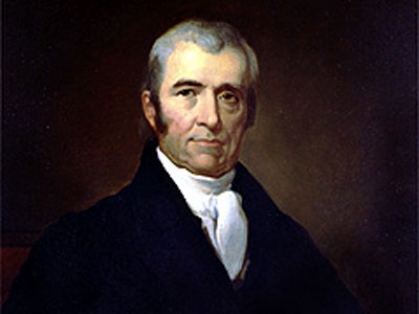
John Marshall
As the circle turns, let’s revisit the question posed above, now that you’ve had time to digest. No harm was done to the Verizon building by the 99% projection, right?
…Unless “image” of “identity” – in this case Verizon’s – can be done harm to. Which is a legal question of importance to art, ownership, market value, and so on, now, especially in the pervasive privileged artificial person scheme for free speech. Which currently equates in one facet to corporate dollars in politics.
What is art up against here? Or more fundamentally, what is expression up against? Privatizing thought, visual space in the commons, thought-occupation-through-content-blitz… These are REAL the systemic disruptions of America’s free speech complex that have concretized over our history, since 1825, [6] into a normative formation.
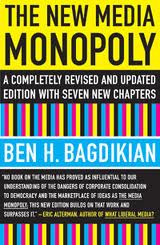
As Ben Bagdikian points out in the seminal text The New Media Monopoly, the business of distribution of expression – the grist of democracy – is determined by a handful of conglomerates, whose prime interest is not democracy and never has been. The Media Industry is a bottom-line operation, as the News Corp/News of the World scandal amply illustrates. In the arena of ideas, “a few bad apples” essentially run the show – and they do not in any way want the 99% to be anything but passive consumers! Is there really any reasonable dispute of this assertion?
4
In the current environment, where “branding” is power, as propaganda, the shaper of thought and discourse, interference with messaging is perceived as a basic threat to doing business. If that business is controlling and commanding hearts and minds, in order to, let’s say, Rule the Whole World, then any disruption of the message matrix is perceived in circles of power as critical. Send in the militarized police! Pull out the sound cannons, the water hoses, the guns, the drones, Homeland Security/FBI/CIA/NYPD & the Contractors!!! Unleash the Kraken! [FOX, Sean Hannity, Mark Levin, Rush Limbaugh, et al.] 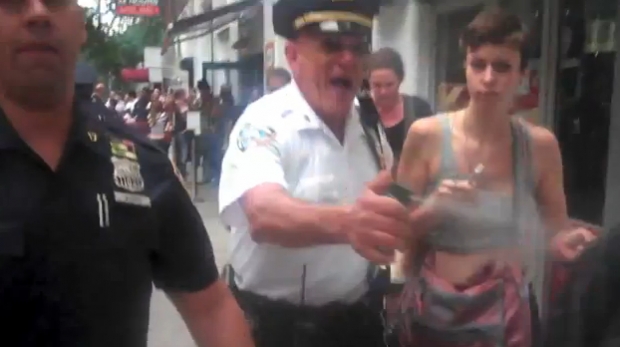
NYPD’s Anthony Bologna in action
OWS has been on the receiving end of reactionary violent disruption, or to use the term with art-action currency, “intervention,” by the likes of Michael Bloomberg, and his affiliates – meaning the US mayors who have hit occupations with pogrom-like clearances, justified by many provisions, ordinances and other technicalities. The brute force employed in some of the authority actions is consequential, and no different than similar top-down suppressions of dissent that have protected Robber Baron interests in the past. Here in America, for the occupations, the aggressive measures have stopped just shy of fatality. I guess comparatively, Homestead was worse. Then, thinking about anarchists, we could mention Haymarket Square, which was one hell of a bloodbath. It cuts both ways.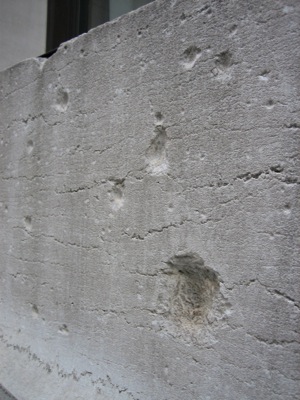
Shrapnel damage at 23 Wall Street
Pepper spray is not the same as hot lead, but the world turns, and the first big Occupy art event, the “No Comment” show, was held at 23 Wall Street, in the old “House of Morgan,” which was bombed, allegedly by anarchists, on September 16, 1920. 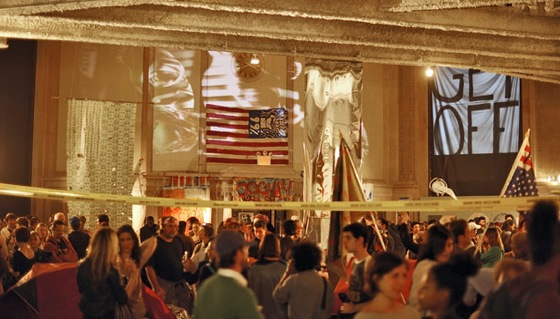
“No Comment” (Photo by David Stam)
A brief disruption, “On anarchy at OWS:” [To speak poetically is to employ codes, and for a code to function it must have rules. If a code is dysfunctional, it won’t have rules, which is the problem with anarchy, as a political instrument. Without democracy, anarchy is useless as an ordering system for social formation. Without representation, democracy is not civilized, only tribal. If one is a member of a 200 or so person tribe, direct democracy is great as a means of social order. Any social order bigger than 200 people cannot function effectively without the establishment of representative mechanisms. Anarchy doesn’t get anywhere without either form of democracy. It’s no surprise that OWS employs both iterations of democracy, now. To say that anarchy is OWS’ “heart,” is to project an illusion, or false representation of anarchy, which is not much more than a concept, or pre-ideology, or anti-idea, since language orders ideas into coded meaning-formations, to have some real-world value to people. A “Cry” is a meaningless sound that humans understand. A baby cries, and the caretaker, usually the mother or father comes. Anarchy might be thought of as a cry. …A movement needs more than a cry to succeed.]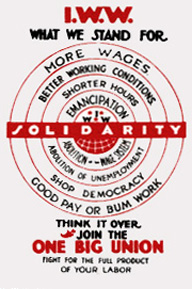
IWW Solidarity Poster
While the world turns, it wobbles. 1% Management Guru Peter Drucker defined himself late in life as an anarchist, but also a conservative and a Christian. If that’s not ironic, nothing is.
5
Cyclic history manufactures irony, which isn’t to say “synchronicity.” It’s more a concentricity, as phenomena go, not a Jungian or Platonic fabrication of the ideal into which the real tries and fails to fit. In a dimensional production, like Wall Street to Main Street, we need to consider the ramifications of echo effects. We need to consider spheres, as a sonic application, and in this case, as a “Cry from the Heart of the World.”
But the Occupation is not localized, post-9-17, or maybe post 11-17. It’s a “Global Uprising.” What are the rules of engagement as we rise up (or ripple outwards)? For OWS, during the occupation, the rules were markedly different for police and protester. The ongoing war on anti-1% protest is a bloody one elsewhere, certainly in the nations enjoying their Arab Spring, which inspired OWS, by its/our own admission. Art and war are not identical, but both are proper enduring functions of civilization, especially the kind of artificial civilization that has been created by the abominable decision of Dartmouth v. Woodward. For example, the “War on Terror” is nothing if not corporate war – artificial, immortal, the proxy of empire, a King’s folly. There is no OWS art of terror.
To get back to the “Bat Signal” example: Again, the “culture jamming” - to reference OWS-generator Adbusters – power of image to disrupt isn’t as consequential as actually knocking over the Verizon building, but it is something. …The Batman is a comic book superhero, and Gotham’s signal to him is a summons in times of crisis. It’s ironic to note that production on the latest franchise Batman Hollywood movie filmed in the NYC during the occupation of Zuccotti Park. Circularity abides fantasy, but who is the real 99% superhero? Who is being summoned by our bat signal, if not us?
Maybe we can learn something about OWS from “Breaking Down,” Richard Dienst’s essay in New Media, Old Media: A History and Theory Reader:
Whatever it tells us about the interplay of media, this complex material makes a startling point: the history of cinema can be told, it seems, everywhere but in cinema. Yet, as the initial episodes insist, the history of cinema is the only history that needs to be told, because only cinema has been capable of telling the story of its time. But it failed, and that is the real story. Only cinema could have constructed the linkages between technology and life required by the modern world; only cinema offered a way to show one life to another without threatening both. Montage - understood first as the production of connections, comparisons, constellations and other kinds of relationality - is the only form, the only technique, cinema has to offer to help us live historically. All the rest - its plots, its clichés, its obedience to ruling ideas and awful prejudices - would be precisely what montage could undo by cutting open. But, again, cinema got caught up in everything but pursuing its only real task. The "beautiful care" [beau souci] of montage turned out to be a burden heavier than any film, or any filmmaker could bear: it is nothing less than the obligation to make history out of every image, to know how to slip dreams into reality, when to splice memory into the flow of forgetfulness, and moments of beauty into unfolding catastrophes of modern life. Cinema let us know that all these images are somehow *there*, adjacent to each other, if not us. We do not lack for images; if anything, the images lack a "we" who could bring them together.
If OWS illustrated the difference between Batman and the new hero, it also clarified the praxis of montage. We have to unmask ourselves, first.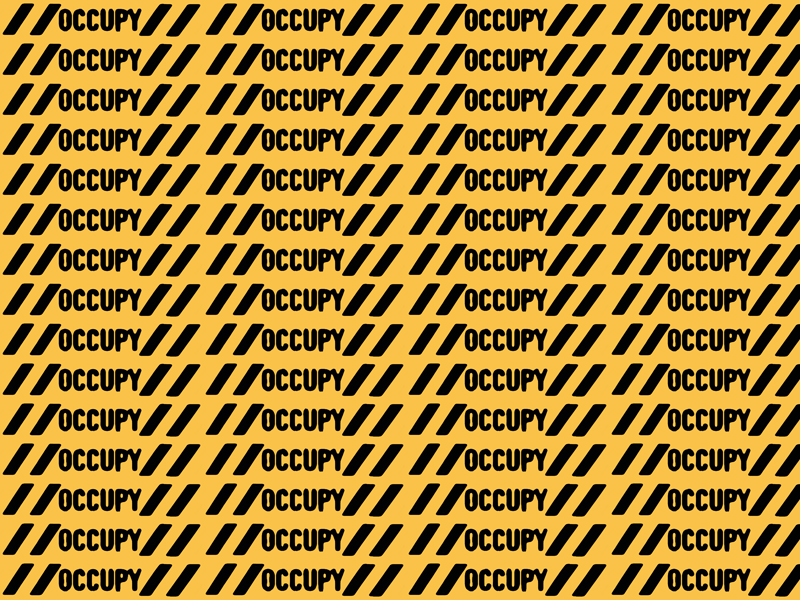
Graphic by Anjin Anhut
6
More to the point, OWS clarified and is clarifying the impact of non-message, when the montage suffices. If the OWS message is fluid, or maybe “wireframe,” like the movement itself, post-eviction, then can it have a lasting impact on the rest of the country? Given all the environmental interference, can it even reach the rest of the country, except as a montage? The polls – and this apparently was a tremendous surprise to corporate media pundits at the time – showed that OWS was “LIKED” in the Facebook sense by a majority of Americans. More New Yorkers liked OWS than liked Mayor Bloomberg! How did that happen? Could it be that OWS was better than any movie in the Cineplex? Maybe OWS-as-neo-montage does work!
So, instead of the message, let’s ask about what OWS is (and is not). Obviously, many people – including politicians and CEOs and their operatives, members of the “free press” and folks all over the USA – are still struggling to generate a reductive terminology for OWS. So far, nothing’s done the bullet-point trick. …Right after they express their confusion and/or criticism over what OWS is and is about, or isn’t, the Opinion Man, Inc., will stare into the camera with glassy eyes and shake his head, still. OWS doesn’t have one Frank Luntz type. Maybe 99.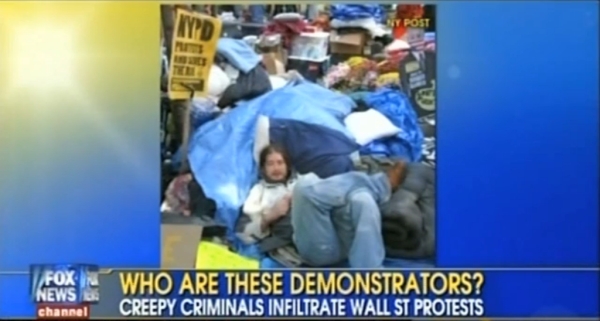
FOX screengrab
So, for clarification’s sake, let’s settle on OWS being a collective/subjective “it.” Occupation is a subject like all others. Time is the only Object. What are the peculiar qualities of OWS all-and-one subjollectivity? That question might not have a good reducible answer.
I have other questions:
• Is OWS mobile?
• Does it translate?
• How prone to distortion is it?
• Does it echo?
These are dimensional, technical questions. From my perspective, they are also questions that get to the presumption that art is integral to OWS. The only way to find out with both art and OWS, is to take them on the road, to folks who speak a different language, try to keep in real, and deal with the feedback. That’s a Wall Street to Main Street proposition, and we don’t know the answers, yet.
7
OWS and art have been linked from the September 17, 2011 inception of the movement. There is much new and old, historical, in the ways in which art has appeared in occupations, and certainly there is much that is worth close study. What can we learn from the role of expressive arts as a complement to Occupy protest? If status quo Wall Street has been in some aspects disrupted by OWS, it’s also clear that the art of occupation is disturbing some entrenched notions about what art and artist are, now, or can be. Occupy Museum and the Arts & Labor Working Groups have done great things in this area, but the phenomenon of OWS itself has outperformed the Situationists, Relational Aesthetes, and a laundry list of other immaterialists, agendists, radicals or Avant Gardists, contemporary and not. Protest-as-lawful-expression obviates the politically correct portfolio of binary presumptions, and the tropes of Otherness don’t jibe with a 99% maxim. Not only have the Righties been stumped by OWS, but so have the Lefties. OWS is cleaving to the middle, like Lao Tzu. People forget that the Tao te Ching is a protestation, at least in its facets.
When we consider the Constitutional protections for peaceable assembly for the redress of grievances, underscored as they are by fundamental rights of American citizens to free speech, we may recall where art situates in the spectrum of our commonwealth exchange. We don’t have to stop there, however. We may continue spinning the wheel, looking for a more substantial art, one that provides a basis for another economy, or maybe ecology. The old adage goes, “You can’t eat art.” It gets at something invaluable about art, which is its non-consumable nature. In today’s “art world,” which is to say, the 1% art market with which Art is routinely and wrongly conflated, the collector, whether institutional or individual, gets to play consumer of art. Almost no one else does, for a Jeff Koons atrocity, for example. We’ll be looking elsewhere for a model on how to grow art for a 99% marketplace that will outperform the current one.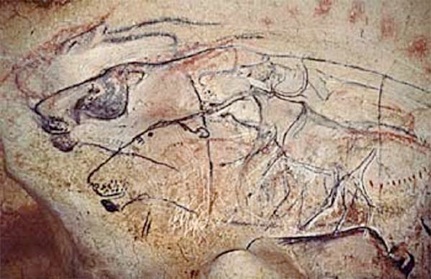
Chauvet Cave
Before we commence our project, we can establish a base sample. I suggest Chauvet and Lascaux. [7] Why not? Especially in the Chauvet case, we have a prime illustration of the value of preservation, which at Chauvet involved a fortuitous rock fall. Preservation is the opposite of consumption. Somehow, in our new market for the 99% art, we have to instill valuation on preservation, flip-flopping the mechanics of civilization corrupted by thousands of years of extraction/exploitation. The fuel for the e/e machine is consumption. It’s time to turn off that tap.
Then we can jump ahead on the time line to now. We have to begin with a systemic review, an evaluation, for the love of wisdom. Philosophy is handy in this undertaking. What is art for? We can simultaneously abstract and concretize the analysis, to begin, because art encompasses both tangible and intangible. Art spans the material and immaterial in a healthy society. We can play with juxtaposition, too. What’s the prevalent obverse, or converse? In a toxic society, and let’s talk specifically in the moment of New York City, USA, money has displaced art as the prime exchange utility (or at least so one would assume, let’s say, walking down Broadway toward the stock exchange from city hall). Art in NYC runs like a business, and that business’s #1 characteristic is consumptive waste. We can decide to not be Dark Matter, as Gregory Sholette calls it.
If I seem to be drifting here, it’s only a seeming. The diverse concerns and/or propositions and/or conditional or environment analyses shuffled through above are vital to figuring out what is at stake. I’ll cut to the chase. This essay is for the project Wall Street to Main Street. We’re linking OWS with Catskill, NY. We’re building a throughput between Zuccotti Park and Main Street, Catskill. Art is the instrumentation for this unification attempt, or convergence, or migration, at least that’s the projected impetus. However, even in the initial phase of this production, which is where we are as of this writing, art is unquestionably only one component in the mix. Art is like the roux in the gumbo. 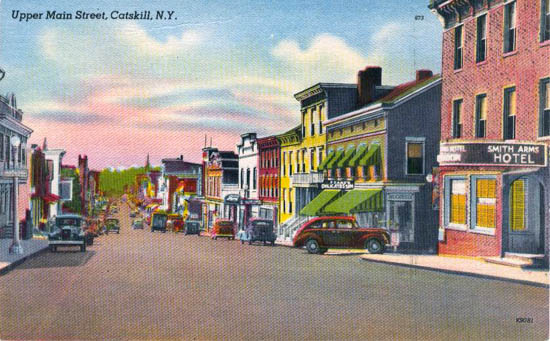
USGenWeb Archives
We’re going to insist that OWS not be contained in a 1% perceptual cage. Occupation is not a contagion to be quarantined. It is democracy that must be once more, and maybe finally revolutionized. Maybe WW1 and 2 weren’t wars to end all wars. Maybe the only one to finish now is the one to be waged against the 1%. If there’s a chance art can win it, before the 99% start killing people and breaking things, I think it’s worth the shot.
∞
We have to acknowledge Occupy Wall Street is an imaginary, now, a virtual thing, a replicant. Sure, OWS exists in iterative form all over, at least that’s true as the New Year approaches. Who knows what Occupy will mean in March, April and May, 2012, the months we’ve slated for Wall Street to Main Street? The concentricity of the movement has facilitated some promise of a continuity of insistence. If we’re still transmitting in a few months, what will our reception be, then? A lot can happen! We do realize that enemies of OWS – they hate us for our freedom – will continue to wildly distort Occupy to “Main Street.” Friends of OWS already uncovered one big-money campaign to trash the movement by any media-means available. We assume now that corporate media and other disinfo-machines will do everything possible to ensure that the hyperreal OWS is reduced to a crap consumer product, yesterday’s news, like wrappers for McDonald’s burgers tossed on the sidewalk, in time for next year’s elections. I think we have a concentric app for that.
When WS2MS is installed in Catskill, a version of OWS will surely pre-exist for our potential collaborators upstate. Will it be our projection, or theirs? If OWS were on trial, which in some sense it is (for what crime?), the defense would be able I think to argue that the jury pool is effectively tainted. There are a lot of powerful 1% entities – like Goldman Sachs, the two Parties, Bloomberg, to name only a few – who have substantial interests in disrupting or spinning whatever OWS is as a phenomenon or complex of phenomena. They hate us ‘cause we’re “off-message.” They need to preserve the status quo, the one that’s good for the 1% and cataclysmic for the rest of us. 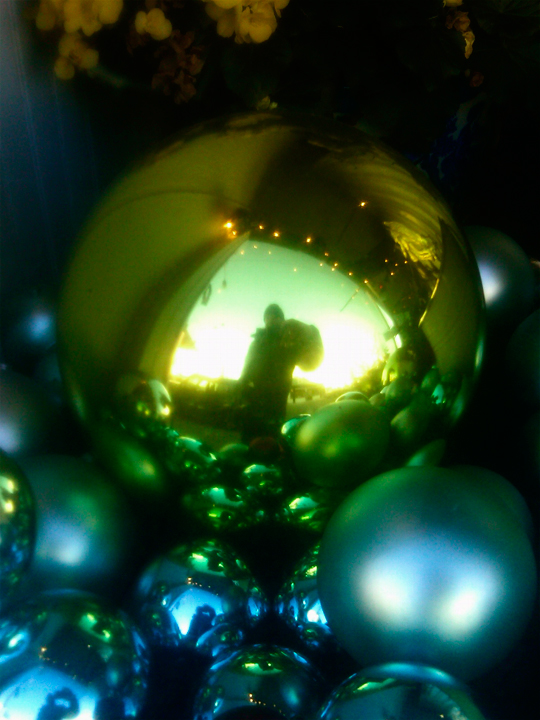
Photo: Paul McLean
Probably the idea of WS2MS initially sparked as an outreach or diplomatic transmission to short circuit the anti-OWS propaganda. At this point, what’s becoming apparent is that network dynamics must be foregrounded. The non-problematic problem is, we don’t know what that really means. As with all things OWS thus far, we are seeing the unexpected as the typical. Some key alliances that are emerging as parallel productions for WS2MS in OWS and the Hudson River Valley are not art-centric. Our discovery process is revealing 99% needs.
This is because we’re asking questions, rather than occupying space. (e.g., “What does a 99% art school look like?”) We’re – meaning Occupy with Art, the artists, the “PROJECT,” and the Catskill collective, whatever and/or whoever that will be – not presuming anything. [8] We’re staging this collaboration with the presupposition that OWS and Main Street, Catskill share a commons, a 99% imperative. We’re finding this to be a productive dynamic, for translation purposes, but also for a greater purpose, a Life-driven one. That means we’ll be asking how we can help.
“The beginning of the beginning” projected in the Bat Signal is true in a movement orientation, but we’re discovering in our process that there is a pre-extant history in the Hudson Valley that doesn’t necessarily require a re-beginning, so much as a recollection. This is true with respect to American art, invention, education, industry and democracy. It’s also true with respect to the question of the indigenous populations of the North America, if we are really committed to “drilling down” to beginnings. How will our project deal with such pre-realities? [Fortunately, in this instance, we’re beginning our project in Chauvet cave – remember?] So, we will be occupying ourselves with the history of place, as was done in Zuccotti Park, aka Liberty Plaza or Square. 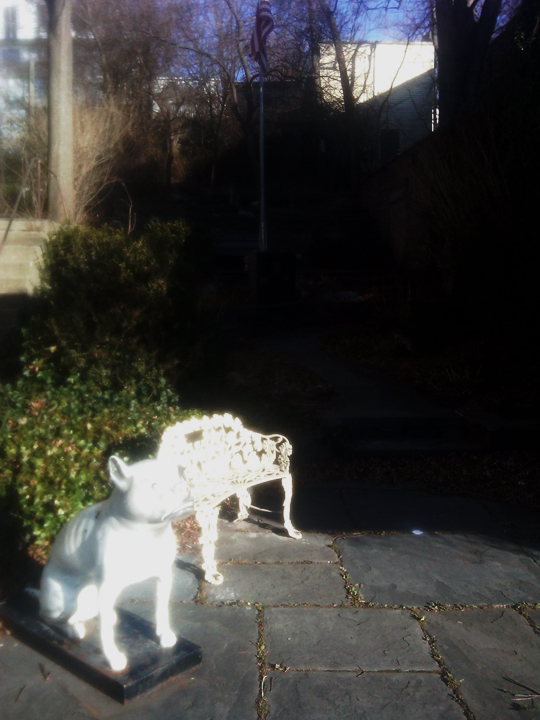
Photo: Paul McLean
And what of the commons, the “ours,” which is identically in the sounding (in my native dialect, anyway) to the Latin “ars?” We can sense the ominous shift to endgame, from the 1% top down. We’re hearing about outrageous bails being set for jailed protester, and felony charges proliferating. The harassment is escalating to the point one can’t stand on a sidewalk anymore, without a cop agitating one to “move on” or get shackled. In America! Then there are dramatic changes to Federal law, permitting the enforcers to detain anyone for nothing or anything, without trial. The confrontation is reducing our struggle to one that encompasses the trajectory of total co-optation of the nation by un-democracy.
What is the endgame? The 1% is committed by any means necessary to “privatizing” the commonwealth entirely, isn’t it? Are we willing to accept the proposition that civilization itself has to run more like a business? How much of our society will have to be for-profit before we put a stop to the wastefulness of that, the “creative obsolescence,” so to speak, of mankind. Will our commons only serve as a mechanism to maximize the profit of the few over the welfare of the rest of us? Planning some storefront installations and panels in Catskill may not seem like much to the 1% right now, but it’s something. We’re going to do our best to make it something special, and maybe even important.
[1] Technically, no: Comcast bought with FCC approval NBC-Universal from GE, although GE still owns a 49% stake. See: http://www.freepress.net/ownership/chart/main
[2] See Brooklyn Rail, December 2012 for the first-person account: http://www.brooklynrail.org/2011/12/local/the-99-bat-signal-a-cry-from-the-heart-of-the-world
[3] Thomas Cole’s home is a national historic site in Catskill. The great website hosts a wonderful online gallery cataloguing his art: http://www.explorethomascole.org/
[4] David Graeber and others claim that the roots of OWS are anarchist, and promulgate a revisionist-historical review of revolution that excludes the American one, which was the first successful agrarian revolt by a colony from its empire/holding-company on a nation-establishing scale. For amplification of the subtle meme, see Graeber’s essay for Adbusters, which starts the revolutionary timeline with the French one. http://www.adbusters.org/magazine/99/world-revolution-2011.html
[5] “Agrarian Justice,” by Thomas Paine: http://geolib.com/essays/paine.tom/agjst.html
[6] See Dartmouth v. Woodward, which introduced the concept of the infinite artificial person as property-owner/consumer into the lexicon of American jurisprudence: http://www.constitution.org/dwebster/dartmouth_decision.htm
[7] See Werner Herzog’s Cave of Forgotten Dreams or read Joseph Nechvatal’s Immersion Into Noise
[8] For a systemic analytic model, we will use Hegel’s Phenomenology of the Spirit or Mind [Geistes], especially sections 73-89 of the introduction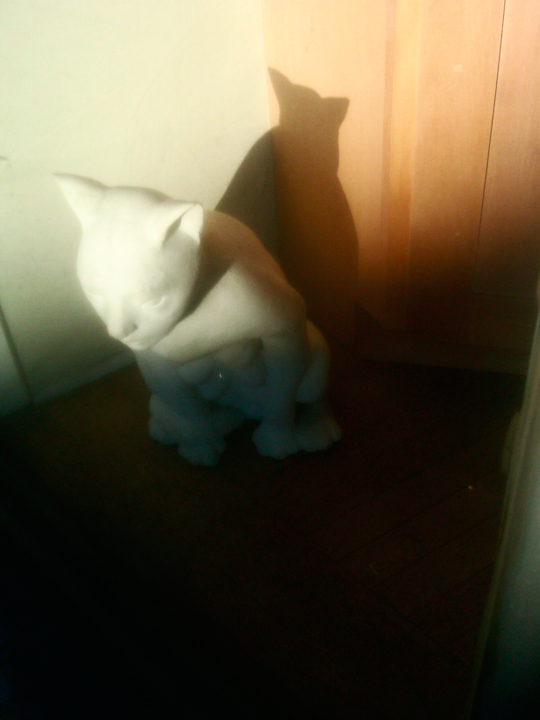
Photo by Paul McLean
Paul McLean is an artist who works in both new media and traditional fine art. He is a co-organizer of Occupy with Art. His research interests include media philosophy, specifically pertaining to time and systems; arts management, art, and cultural economics; and the convergence of 4-D methodologies among military, political, business, and social sectors. His web site is www.artforhumans.com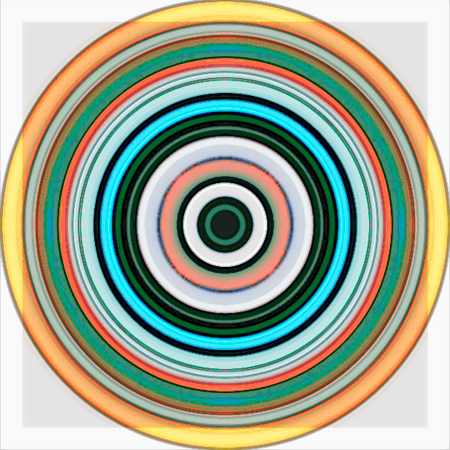
www.occupywithart.com
 admin |
admin |  Post a Comment |
Post a Comment |
Reader Comments